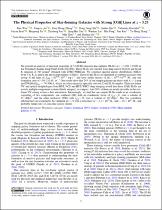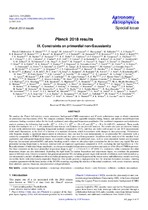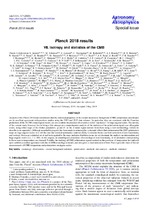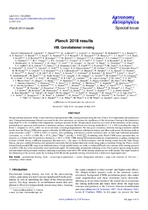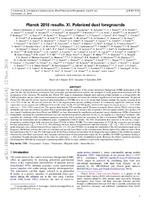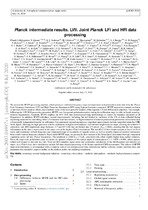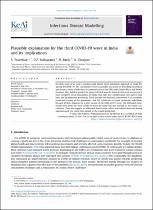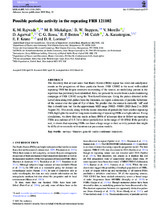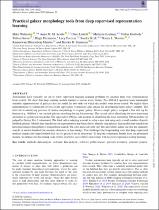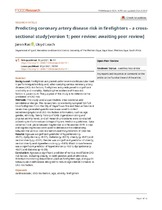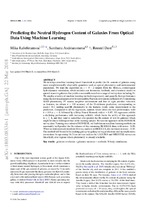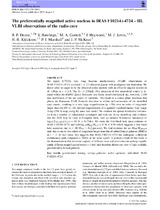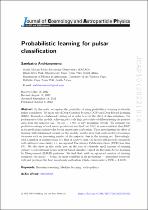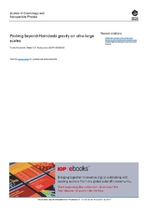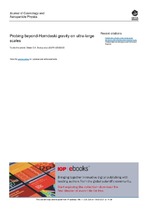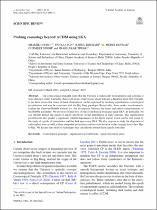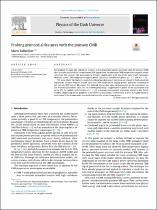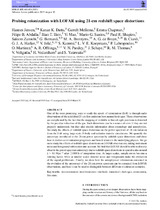Browsing Research Articles (Physics) by Title
Now showing items 371-390 of 510
-
The physical properties of star-forming galaxies with strong [oiii]lines at z=3.25
(IOP Publishing, 2022)We present an analysis of physical properties of 34 [O III] emission-line galaxies (ELGs) at z = 3.254 ± 0.029 in the Extended Chandra Deep Field South (ECDFS). These ELGs are selected from deep narrow H2S(1) and broad Ks ... -
Pks 1830-211: oh and hi at z = 0.89 and the first meerkat uhf spectrum
(EDP Sciences, 2021)The Large Survey Project (LSP) "MeerKAT Absorption Line Survey"(MALS) is a blind H I 21 cm and OH 18 cm absorption line survey in the L- and UHF-bands, primarily designed to better determine the occurrence of atomic and ... -
Planck 2018 results IX. Constraints on primordial non-Gaussianity
(EDP Sciences, 2020)We analyse the Planck full-mission cosmic microwave background (CMB) temperature and E-mode polarization maps to obtain constraints on primordial non-Gaussianity (NG). We compare estimates obtained from separable ... -
Planck 2018 results VII. Isotropy and statistics of the CMB
(EDP Sciences, 2020)Analysis of the Planck 2018 data set indicates that the statistical properties of the cosmic microwave background (CMB) temperature anisotropies are in excellent agreement with previous studies using the 2013 and 2015 data ... -
Planck 2018 results VIII. Gravitational lensing
(EDP Sciences, 2020)We present measurements of the cosmic microwave background (CMB) lensing potential using the final Planck 2018 temperature and polarization data. Using polarization maps filtered to account for the noise anisotropy, we ... -
Planck 2018 results. XI. Polarized dust foregrounds
(EDP Sciences, 2020)The study of polarized dust emission has become entwined with the analysis of the cosmic microwave background (CMB) polarization in the quest for the curl-like B-mode polarization from primordial gravitational waves and ... -
Planck intermediate results. LVII. Joint Planck LFI and HFI data processing
(ESO, 2020)We present the NPIPE processing pipeline, which produces calibrated frequency maps in temperature and polarization from data from the Planck Low Frequency Instrument (LFI) and High Frequency Instrument (HFI) using ... -
Plausible explanation for the third COVID-19 wave in India and its implications
(KeAi Communications, 2023)Recently some of us used a random-walk Monte Carlo simulation approach to study the spread of COVID-19. The calculations were reasonably successful in describing secondary and tertiary waves of infection, in countries such ... -
Possible periodic activity in the repeating FRB 121102
(Oxford University Press, 2020)The discovery that at least some Fast Radio Bursts (FRBs) repeat has ruled out cataclysmic events as the progenitors of these particular bursts. FRB 121102 is the most well-studied repeating FRB but despite extensive ... -
Powder characteristics blending and microstructural analysis of a hot-pack rolled vacuum arc-melted gamma-tial-based sheet
(The Southern African Institute for Industrial Engineering, 2022)In the quest for cost-effective fabrication processes capable of producing sound γ-TiAl products, the microstructure and mechanical properties of a modified second-generation hot-rolled γ-TiAl-based alloy with nominal ... -
Practical galaxy morphology tools from deep supervised representation learning
(Oxford University Press, 2022)Astronomers have typically set out to solve supervised machine learning problems by creating their own representations from scratch. We show that deep learning models trained to answer every Galaxy Zoo DECaLS question ... -
Predicting coronary artery disease risk in firefighters – a cross-sectional study
(2021-07-30)Background: Firefighters are placed under severe cardiovascular load in performing active duty and, when carrying various coronary artery disease (CAD) risk factors, firefighters are predisposed to significant morbidity ... -
Predicting the neutral hydrogen content of galaxies from optical data using machine learning
(Oxford University Press, 2018)We develop a machine learning-based framework to predict the Hi content of galaxies using more straightforwardly observable quantities such as optical photometry and environmental parameters. We train the algorithm on z ... -
The preferentially magnified active nucleus in IRAS F10214+4724 - III. VLBI observations of the radio core
(Oxford University Press, 2013)We report 1.7GHz very long baseline interferometry (VLBI) observations of IRAS F10214+4724, a lensed z = 2.3 obscured quasar with prodigious star formation. We detect what we argue to be the obscured active nucleus with ... -
Probabilistic learning for pulsar classification
(IOP Publishing, 2022)In this work, we explore the possibility of using probabilistic learning to identify pulsar candidates. We make use of Deep Gaussian Process (DGP) and Deep Kernel Learning (DKL). Trained on a balanced training set in ... -
Probing beyond-Horndeski gravity on ultra-large scales
(2020)The beyond-Horndeski gravity has recently been reformulated in the dark energy paradigm — which has been dubbed, Unified Dark Energy (UDE). The evolution equations for the given UDE appear to correspond to a non-conservative ... -
Probing beyond-Horndeski gravity on ultra-large scales
(IOP Publishing Ltd, 2020)The beyond-Horndeski gravity has recently been reformulated in the dark energy paradigm — which has been dubbed, Unified Dark Energy (UDE). The evolution equations for the given UDE appear to correspond to a non-conservative ... -
Probing Cosmology beyond ΛCDM using the SKA
(Indian Academy of Sciences, 2023)The cosmological principle states that the Universe is statistically homogeneous and isotropic at large distance scales. Currently, there exist many observations which indicate a departure from this principle. It has ... -
Probing primordial features with the primary CMB
(Elsevier, 2019)We propose to study the imprint of features in the primordial power spectrum with the primary CMB after the subtraction of the reconstructed ISW signal from the observed CMB temperature angular power spectrum. We consider ... -
Probing reionization with LOFAR (Low Frequency Array) using 21-cm redshift space distortions
(Oxford University Press, 2013)One of the most promising ways to study the epoch of reionization (EoR) is through radio observations of the redshifted 21-cm line emission from neutral hydrogen. These observations are complicated by the fact that the ...

